Since 2007, the Young Geomorphology have been organizing annual meetings at various venues across Germany. Presentations of participants‘ research, including talks and posters, as well as keynote lectures and workshops, are among the most important components of these gatherings. Additionally, we offer a one-day excursion each year and reserve ample time for informal and open discussions. In recent years, we have been working to strengthen contact with international groups of young geomorphologists and successfully hosted our first international meeting in 2014.
International Young Geomorphology Meeting, 19-22 June 2025
Report_and_program_2025
Following the success of last year’s meeting at Wanderheim Belchenblick in the Black Forest, the German Young Geomorphology organized the 2025 International Young Geomorphology Meeting at Ökodorf Losheim, located in Losheim am See, Saarland (Germany), just a few meters from the lake. The event took place from June 19th to 22nd, 2025. An excursion focusing on geomorphology, soil science, and geology in the vicinity of the Mosel Valley around Trier was held on June 20th. Participants joined from Germany, Switzerland, France, Italy, and Egypt, forming a diverse group of 37 early-career professionals and students, ranging from Bachelor’s students to post-doctoral researchers, representing a total of 17 institutions. The program was designed to encompass a broad spectrum of academic topics and activities, fostering a rewarding and enriching experience for all attendees. The meeting featured five sessions of oral presentations with brief discussions, an afternoon poster session, an inspiring keynote talk on the influence of climate on mountain erosion, and a candid panel discussion on life in academia and transitioning from academia to industry.
Proceedings
Most participants arrived on Thursday evening. Due to the remote location of the venue similar to 2024, a shuttle service was arranged from Merzig train station to facilitate group transportation. Prior to dinner, a short welcome speech and an icebreaker activity took place, where participants searched for their name badges on the necks of others. This was followed by the traditional Scale Game and a pub quiz, fostering a friendly atmosphere and promoting informal conversations that extended beyond research topics.
On Friday morning, after an early breakfast, the group departed for the greater Trier region to meet with our excursion guide, Dr. Raimund Schneider (University of Trier), and commence the field excursion. Following a brief introduction to the geology and geomorphology of the area surrounding our accommodation, we enjoyed an impressive overview of the abandoned Mosel valleys near Trier. The excursion included a discussion of a soil profile in the Hunsrück region on schist bedrock. Lunch was served at the University of Trier. In the afternoon, the field trip continued north of the Mosel River, where we examined a soil profile on Buntsandstein bedrock and concluded the excursion with a sediment-paleosol sequence in a former gravel pit between Hetzerath and Klüsselrath. The field trip was co-hosted by Lars Engelmann from the Young Geomorphology (YG) board. On the return journey, participants appreciated the scenic views of the Mosel Valley and its vineyards. Upon returning to Ökodorf Losheim, we enjoyed a vegetarian barbecue dinner, after which we took the opportunity to present the activities of the Young Geomorphology and the responsibilities of the board. We also briefly introduced the DGGM (Deutsche Gesellschaft für Geomorphologie) as our parent organization, along with the DEUQUA, one of our sponsors. We emphasized that the Young Geomorphology encompasses not only the board members but also all meeting participants. To promote inclusive decision-making, last year we distributed a questionnaire soliciting opinions on the discipline, our meetings, and the group’s name. One result, which was welcomed by this years participants, was the adoption of the name “Junge Geomorphologie”/“Young Geomorphology,“ reflecting gender-neutral language, replacing the previous German masculine form. The evening featured a captivating panel discussion with Dr. Mario Kirchhoff, who shared his inspiring academic journey in geomorphology and his decision to leave academia. Mario provided insights into balancing private life with a scientific career, as well as the challenges associated with extended absences from home. The discussion highlighted internal conflicts regarding life inside and outside academia, networking, and building meaningful collaborations, alongside a passion for research. The day concluded with a relaxed gathering both inside and outside the Ökodorf.
Saturday commenced with a keynote lecture by Prof. Dr. Melanie Kranz (University of Bochum), who presented on the impact of Quaternary climate changes on mountain erosion, as revealed through trapped charge thermochronometry. Her talk offered innovative perspectives on ESR-dating techniques for understanding geomorphological processes and reconstructing Quaternary climatic conditions. The day continued with engaging sessions on uplift and erosion rates in the Tianshan Mountains, part of the “Earth in Motion” session, followed by presentations on sediment sequences and their implications for paleoclimatology in the “Climate Signals” session. After lunch, participants attended further talks on coastal sedimentation processes, storm impacts, and sea-level changes during the final session, titled “What happens at the coast: From process to human influence.” A highlight was the “30 Seconds Poster Madness,” where each presenter had 30 seconds to introduce their work. The subsequent poster session around the venue showcased 12 diverse posters, provoking stimulating discussions and knowledge exchange on topics ranging from human-environment interactions in fluvial systems to snow cover dynamics in the Rhoen Mountains. Following dinner, a “Failure Session” was held at the lakeside – a rather new format introduced some years ago, opening the floor for discussions about scientific failures and mishaps. The session aimed to share the inevitable challenges and setbacks encountered during research, helping participants learn from each other’s experiences and normalize failure as part of scientific progress. This year’s anecdotes covered fieldwork, laboratory experiments, and data analysis. The day concluded with informal discussions on scientific and personal aspects of research, both at the lake and around the Ökodorf.
On the final day, Sunday, we gathered for our last two sessions, which focused on „Fluvial archives“ and on UAV photogrammetry as well as climate reconstruction in the “Hot and Cold” session. After our last shared lunch, it was time to say goodbye for the participants and leave some feedback for next year.
Feedback
We received overwhelmingly positive feedback regarding this year’s meeting, especially praising the program structure and the remote lakeside setting. The panel discussion, the pubquiz, and the extensive excursion were highly appreciated, as they facilitated rapid and meaningful social interactions among participants.Overall, the International Young Geomorphology Meeting at Ökodorf Losheim proved to be an inspiring, and socially enriching experience. We hope we were able to offer lasting memories, strengthened connections, and renewed enthusiasm for geomorphology.
With warm regards from the old and new board of the German Young Geomorphology,
Andreas, Bastian, Charlotte, Dennis, Felix, Isabel, Jannik, Katharina, Lars, Lingxiao, Lisa, Niklas, Philipp and Salome
18th International Workshop of Young Geomorphologists, 23-27 May 2024
Report_and_program_2024
Following the successful meeting in Berlin (Wannsee) last year, the Young Geomorphologists held the 18th International Young Geomorphologists Meeting at the Wanderheim Belchenblick in Neuenweg, located right at the foot of the 3rd highest peak (the “Belchen”) of the Black Forest, from May 23-27, 2024. The event featured an additional excursion about the Pleistocene Glaciation of the Black Forest, supported by the DEUQUA (German Quaternary Association), on May 24th. With participants working in Germany, Austria, and Switzerland, the event welcomed a diverse group of 35 early-career professionals and students, ranging from Bachelor’s to post-doc level, while representing a total of 13 different institutions. The meeting’s program was thoughtfully designed to encompass diverse academic topics and activities, ensuring a rewarding and enriching experience for all attendees. It featured five sessions of oral presentations with short discussions, an evening poster session, an inspiring keynote talk on the crossroads of geomorphology and Quaternary geochronology, and a candid panel discussion centered on academic life. During an exciting workshop, the participants had the opportunity to gain insight into the principles of risk assessment and fieldwork safety, as well as the chance to reflect on themselves and their working group with regard to these topics.
Proceedings
Most of the participants at this year’s meeting arrived on Thursday evening. As the meeting location was somewhat more remote than in previous years, a shuttle transfer was organized from Bad Krozingen train station to bring all participants together. The scenic drive along smaller roads in the Black Forest was a good first opportunity to get to know each other. Dinner was followed by a short welcome and an enjoyable icebreaker, where participants had to search for their own name-badge on the neck of other participants. It provided a fantastic opportunity for everyone to introduce themselves. Afterwards, we then delved into a YGM pub quiz, creating a friendly atmosphere and encouraging personal conversations that extended beyond the boundaries of research topics. Friday morning began with breakfast with a nice view down into the valley. We then started the excursion with our host Dr. Felix Martin Hofmann (University of Freiburg). After a short introduction to the geology and the glacial geomorphology of the region near our stay, we walked through beautiful glacial landscapes, which we discussed at some sites. We had lunch at the Fischerhütte and then continued at the Nonnenmattweiher, the remainder of a glacial cirque. Here Martin was supported by his master’s student Lena Carduck and they introduced the group to the art of equilibrium altitude line reconstruction and 3D-modelling of glaciers. We enjoyed the most beautiful view of the day from the Köhlgarten directly above the Nonnenmattweiher, from where we had a nice view over the former glacier landscape up to the Belchen. On our way back it started raining heavily, so everybody enjoyed the warm showers and the dinner in the evening. After dinner, we had the privilege of hosting a captivating panel discussion featuring Dr. Claire Rambeau from the University of Strasbourg and Jun.- Prof. Dr. Jan Blöthe from the University of Freiburg. They talked about their inspiring academic careers in the fields of geomorphology and Quaternary geology and gave insights into the compatibility of family life and scientific career as well as the challenges of long absence from home. The discussion highlighted the importance of having a life outside academia, networking and building meaningful connections with colleagues and researchers, as well as the passion for academia. The day ended with a relaxed gathering in and outside the Wanderheim.
Saturday began with an enlightening keynote talk by Prof. Dr. Gilles Rixhon (University of Strasbourg), exploring the crossroads between (fluvial) geomorphology and Quaternary geochronology. The talk highlighted that absolute dating (geochronology) always goes hand in hand with geomorphological understanding of a landscape. The talk provided inspiring insights into the interplay between dating and fieldwork with a particular focus on observing processes as a geomorphologist. The day continued with engaging sessions about absolute dating methods in Quaternary Science in the “Luminescence applications – shine brighter than a diamond” session which was followed by talks focused on sediment storage and storm flood reconstruction in the “Sediment records – Rolling in the deep” session. After lunch, we listened to additional presentations on river long profile modeling, remote sensing, and a presentation on satellite image sonification during the last session of the day “Remote Sensing/Modeling – Nerdy about nature”. Afterwards the “30 seconds poster madness” started, which added a dynamic element to the event, giving each presenter 30 seconds to introduce his or her work and poster. The ensuing poster session around the house featured 9 diverse and captivating posters, generating stimulating discussions and allowing participants to exchange ideas. It was impressive to witness the wide range of topics covered, from geoarchaeological investigations in Egypt to geomorphological mapping on Iceland. Before dinner, the board used the chance to present the work of the Young Geomorphologists and the “duties” of the board. We also shortly presented the DGGM as our mother organization, and the DEUQUA, as the sponsor of our one-day field trip. We also wanted to emphasize that the young geomorphologists are more than just the representative board but rather include all participants of the meetings. In order to involve more people in upcoming decision-making processes, we created a questionnaire in which we asked for their opinions on the disciplines covered, the meetings, the name of the group, and so on. We hope to share the results of this survey soon. After dinner, we had our 2nd “Failure Session”, which we introduced last year with great success. The session’s aim is to openly share the struggles and inevitable failures that all researchers encounter during their journeys. As last year, we want to help others avoid similar pitfalls and gain valuable insights as well as to embrace the normalcy of failure in our endeavors. This year, the session was again a valuable addition to the conference, as it included a variety of anecdotes about field trips and the laboratory as well as fieldwork, while creating an encouraging atmosphere. The day ended with participants discussing both scientific and personal aspects of their research and studies.
On the final day, Sunday, we gathered for our last two sessions, which focused on “(Rock) glacier dynamics and mountain environments – Ice Ice baby” and the human influence on fluvial systems as well as infrastructure in the “Human influence – Homo faux pas” session. After our last shared lunch together, it was time to say goodbye for a majority of the participants and leave some feedback for next year, while some participants stayed for the “Fieldwork safety workshop” with Floreana Miesen (University of Lausanne) about risk assessment and (team) safety during fieldwork. About 10 people including most of the board stayed overnight and cleaned up the Wanderheim.
Feedback
We were delighted to receive an overwhelming amount of positive feedback for this year’s meeting, particularly regarding the program and the remote setting in the lovely mountains of the black forest. The panel discussion, the “Failure Session” and the long excursion beforehand were very well received, also because people get to know each other very quickly and easily. Overall, the 18th International Young Geomorphologists’ Meeting in the Wanderheim Belchenblick proved to be an inspiring, intellectually stimulating, and socially rewarding experience. We depart with cherished memories, strengthened connections, and a renewed passion for the field of geomorphology.
With warm regards from the board of the Young Geomorphologists,
Andreas, Bastian, Dennis, Isabel, Lars, Laura, Linda, Lisa and Salome
17th International Workshop of Young Geomorphologists, 9-11 June 2023
Report_and_program_2023
Following last year’s successful meeting in Bad Kreuznach, the Young Geomorphologists hosted the 17th International Young Geomorphologists Meeting in Berlin on the shore of the scenic Wannsee on June 9-11, 2023. The event also featured an additional excursion to the surrounding area on June 12. Gathering participants from Germany, Italy, Spain, Switzerland, and Ireland, the event welcomed a vibrant and diverse group comprising 38 early-career professionals and students,
ranging from Bachelor’s to Post-Doc level and representing a total of 15 different institutions. The meeting’s program was thoughtfully designed to encompass a diverse range of academic topics and activities, ensuring a rewarding and enriching experience for all attendees. It featured three engaging sessions of oral presentations with short discussions, an evening poster session, an inspiring keynote talk on the geomorphological landscapes of Berlin and its greater surroundings, and a candid panel discussion centered on academic life. Additionally, participants had the opportunity to explore the glacial-formed landscape of the city of Berlin during an exciting excursion (see attached program for details).
Proceedings
This year’s meeting kicked off with a warm welcome from the organizing committee, followed by an enjoyable icebreaker known as the „Scales Game,“ fostering initial interactions among attendees. It provided a fantastic opportunity for everyone to introduce themselves and share their research projects briefly. Building on the camaraderie, we then delved into an animated „Personen Bingo,“ creating a friendly atmosphere and encouraging personal conversations that extended beyond the boundaries of research topics. After the following dinner, we had the privilege of hosting a captivating panel discussion featuring Prof. Dr.
Julia Meister from the University of Würzburg. She shared her inspiring academic journey in geomorphology and geoarcheology, along with valuable insights into balancing family life and a scientific career, and the challenges of frequent work-related travel. The discussion highlighted the importance of curiosity, building meaningful connections with colleagues and researchers, and maintaining a passion for academia. The first day concluded with a relaxed gathering at the youth hostel, where participants enjoyed each other’s company and exchanged ideas in a casual setting. Saturday began with an enlightening keynote talk by Prof. Dr. Margot Böse (former FU Berlin), delving into the geomorphological landscapes of Berlin and the surrounding areas of Lake Wannsee within an´anthropogenic context. The talk highlighted fascinating aspects, demonstrating that geomorphology remains applicable and vibrant even in urbanized cities like Berlin. It was truly inspiring to witness the interplay between natural processes and human activities shaping the landscape. The day continued with engaging sessions on absolute dating methods in Quaternary Science in the „Dating Apps“ session, and intriguing talks on glacial geomorphology and landscape evolution modeling during the „Ice Ice Sediment Baby!“ session. The „30 seconds madness“ poster session added a dynamic element to the event, giving each presenter a brief window to introduce his or her work. The ensuing poster session Report of the 17th International Young Geomorphologists’ Meeting, featured 15 diverse and captivating posters, generating stimulating discussions and allowing participants to exchange ideas. It was impressive to witness the wide range of topics covered, from geoarcheological landscape changes in Tunisia to methodological analyses in OSL dating. To infuse a sense of informality and novelty, we introduced a fresh segment known as the „Scientific Failure session“ at the scenic beach of Lake Wannsee. The concept behind this session was to openly share the struggles and inevitable failures that researchers encounter during their journeys. The aim was twofold: first, to help others avoid similar pitfalls and gain valuable insights, and second, to embrace the normalty of failure in our endeavors. The session became a platform for sharing humorous anecdotes and valuable lessons learned. To conclude the day, we relished the warm sunshine by the lakeside, fostering a relaxed atmosphere conducive to engaging discussions. Participants delved into both scientific and personal aspects of their research and studies. On the final day, Sunday, we gathered for our last session, which focused on „Arid landscapes.“ The presentations brought a perfect conclusion to our scientific exploration. Afterward, we shared our last lunch together and reconvened in the conference hall for a valuable feedback session. The organizing committee concluded the event with their closing words, bidding farewell to half the group while the other 15 participants remained for an exciting excursion.
Excursion
On Monday, we embarked on a grand excursion, replacing the usual workshop format. Our knowledgeable host, Dr. Robert Hebenstreit (lecturer at FU Berlin), met us at a tram station in Berlin city, and together we strolled towards the intriguing locale known as „Kreuzberg.“ Along the way, Robert expertly taught us to discern subtle differences even in cultivated areas, revealing the landforms hidden in plain sight. Once in Kreuzberg, we immersed ourselves in the local glacial geomorphological setting of Berlin and its environs. The expedition provided a wealth of knowledge about the fascinating Urstromtal and the scientific complexities surrounding the glacial landscapes, including the intricate process of dating terminal moraines. Our journey then led us to Hermsdorf, situated north of Berlin, where we explored the harmonious coexistence of humanity with the glacial-formed landscape, showcasing how people harnessed its resources, such as clay pits, for their benefit. Following the enlightening experience in Hermsdorf, we traced the path of the Tegeler Fließ, ending our venture at the serene Lake Tegel with shared cold beers. Investigating the past glaciation of Discussing scientific failures at the Wannsee Berlin with Robert.
Feedback
We were delighted to receive an overwhelming amount of positive feedback for this year’s meeting, particularly regarding the program and engaging talks. The introduction of the „failure session“ also garnered much appreciation for its refreshing and informative approach. However, one significant area of improvement highlighted was the late communication about arrival and departure times. We appreciated this constructive criticism and will make sure to communicate these important details well in advance for next year’s meeting so everyone can arrange for affordable transport. Overall, the 17th International Young Geomorphologists‘ Meeting in Berlin proved to be an inspiring, intellectually stimulating, and socially rewarding experience. We depart with cherished memories, strengthened connections, and a renewed passion for the field of geomorphology. As we look forward to future meetings, we remain grateful for the valuable insights and knowledge exchanged during this unforgettable event.
With warm regards from the old and new board of Young Geomorphologists:
Andreas, Bastian, Dennis, Doris, Emma, Isabel, Johanna, Lars, Laura, Linda, Lisa, Lukas and Salome
16th International Workshop of Young Geomorphologists, 24-26 June 2022
Report_and_program_2022
After two years of online meetings, the Young Gemorphologists held the 16th International Young Geomorphologists‘ Meeting in Bad Kreuznach, Germany (close to Mainz), on June 24-26, 2022, with an additional workshop on June 27. In total, 34 early career and student participants joined from Germany, Italy, Romania, Slovenia, Spain, Switzerland, and Poland. The diverse group included Bachelor’s and Master’s students, doctoral researchers, and postdocs from 22 different institutions. The atmosphere of this year’s meeting was inspiring, joyful and social as the participants discussed scientific topics and academic life in the green hills of western Germany.
The program included five sessions of oral presentations and spotlight talks, two evening poster sessions, a keynote talk, a panel discussion on academic life, and an excursion to a nearby outcrop and viewpoint (see attached program). The sessions for the oral presentations and spotlights were organized as follows:
Sessions I: Advances in permafrost research, with a talk by Rainer Gardeweg from Universitè de Fribourg, Switzerland.
Session II: Mass movements and soil geomorphology, with talks by Laura Paola Calderon Cucunuba from the Università degli Studi di Palermo, Italy, and Iosif-Otniel Lopatita from the West University of Timisoara, Romania.
Session III: Impacts of uplift, lithology and erosion on long-term landscape evolution, with a talk by Romano Clementucci Università degli Studi Roma Tre, Italy, and a spotlight presentation by Bastian Ringleb from Uni Gießen, Germany.
Session IV: Applied remote sensing and geomorphometry, with talks by Ettore Potente from Università degli Studi di Bari, Italy, Doris Hermle from the TU München, Germany, Natalie Barbosa from the Uni München, Germany, and Marcos Moreno-Sànchez from the University of Granada, Spain, and a spotlight presentation by Andreas Ruby from the GFZ Potsdam, Germany.
Session V: Transport and sedimentation in fluvial systems, with talks by Andrej Novak from the University of Ljubljana, Slovenia, and Andrei Ionita from the West University of Timisoara, Romania.
Proceedings
We were lucky to have the participants in person again at our meeting this year. After not seeing each other for a long time, there was some networking to catch up on for a lot of participants. The program started with an introductory game, “the Scales Game”, in which the participants shortly introduced themselves and their research projects. After this introduction, the kitchen was ready for dinner. Then, the participants found a spot in the conference hall and the ‘30 second’ poster session started: every presenter had 30 seconds to present their research. Afterwards, the poster session started. The discussions allowed for valuable feedback, and the presenters also had the possibility to check out the other posters, besides answering questions about their own work. The variety of topics was widespread and covered topics from glacial geomorphology in the Black Forest to dryland geomorphology in the Atacama Desert.
After this session, we had a panel discussion with Prof. Dr. Wilfried Haeberli (former University of Zürich) and PD Dr. Tobias Ullmann (University of Würzburg) about their academic paths and experiences in science. They gave interesting insights into what inspired them to pursue geomorphology, how the field of geomorphology has evolved over time, how to balance family and a scientific career, and also about the struggle of frequent work-related travel. Some takeaway points from this discussion are: for a career in academia, it’s important to stay curious and to develop and maintain contacts with colleagues and other researchers. The first day ended with an open-ended gathering within the youth hostel.
Saturday kicked off with a quick welcome from the organizing committee, which was followed by the keynote talk by Prof. Dr. Wilfried Haeberli. He shed light on new landscapes in high mountains developing due to climate change and discussed potential solutions to the associated increasing hazards. Also, he shared experiences and reflections from high alpine geomorphology.
After a quick break, the first session started in line with the topic of the keynote talk, “Advances in Permafrost research”, with just one presentation. The second session kicked off with two interesting talks about “Mass Movements and soil geomorphology”, with a lively discussion afterwards. After lunch our third session covering two talks about “Impacts of uplift, lithology and erosion on long-term landscape evolution” took place. After this interesting session, Bastian Grimm led a field trip to the surrounding area. We learned about the Tertiary Mainz Basin and discussed the stratigraphy in a sandpit, and then talked about the fluvial geomorphology and evolution of the Nahe River at a viewpoint. There, we enjoyed the sun and the view with some cold drinks before going back to the hostel. The day ended with some free time for discussing, dinner and a continuation of the poster session. Aside from sharing the scientific aspects of their research, participants had the valuable opportunity to discuss their currrent work environment, and issues and progress in their studies or projects.
The third day started with five presentations about “Applied remote sensing and geomorphometry”, each followed by an intesnse discussion. After refilling our cups of coffee in a short break, our last session began with two talks about “Transport and sedimentation in fluvial systems”. We enjoyed the last lunch together and met outside for our last point: the feedback! The last words were by the organization committee before half the group went home, while 15 participants stayed for our “Digital Field Methods” workshop.
Workshop
Monday’s workshop was hosted by Bastian Grimm and Andreas Eberts from the Geological Survey of Rhineland-Palatinate. In the relaxing setting of a local Bad Kreuznach brewery, Bastian and Andreas gave presentations on digital field methods. From Bastian we learned about various smartphone or tablet applications, and Andreas taught us how to create digital outcrop models using structure from motion or LiDAR methods. After lunch, we had a short excursion to test out structure-from-motion photogrammetry using a digital camera mounted on a tripod.
Feedback
In general, the feedback for this year’s meeting was positive, and participants were happy to be able to meet in person again. However, we received some valuable constructive feedback, which is summarized here:
• Include a female guest speaker, in part to enable a discussion on the female-specific issues in an academic career. Also include diversity in background; for example, someone outside of academia.
• Invite YGs to send in discussion ideas for next year’s panel discussion
• More icebreaker games on Day 1, and more evening activities such as PowerPoint Karaoke, or a Pub Quiz.
• Include a discussion on decolonizing science and fieldwork, including fair and respectful conduct when sampling in developing countries.
• Better explanation of Spotlight Presentations (pre-meeting).

With warm regards from the old and new board of Young Geomorphologists:
Andreas, Bastian, Doris, Emma, Janek, Johannes, Johanna, Jörn, Laura, Linda, Lukas, and Nina.
15th International Workshop of Young Geomorphologists, 24-25 June 2021
Report_and_program_2021
The German Young Geomorphologists (YG) conducted the 15th International Young Geomorphologists’ meeting in VIRTsburg Castle (powered by gather.town) from June 24-25, 2021. 56 German and international guests from Austria, Switzerland, India and other countries gathered online for two days due to the Covid-19 pandemic. The list of attendees comprised undergraduate, graduate and PhD students as well as postdocs from a lot of different universities and institutions. The focus was for attendees to present and discuss their own research and general geomorphological topics in a rather informal and friendly environment. Also, we wanted to uphold the tradition of having annual meetings despite the pandemic situation.
The main frame of the program consisted of two thematic sessions of oral and spotlight presentations, one poster session and one keynote talk. The sessions for oral presentations were organized as follows:
Session I: “Landforms as indicators for climate and archaeological reconstructions” featuring talks by Cathleen Kertscher (Leibzig University), Johannes Schmidt (Leipzig University), Sarah Teuber (Technical University of Braunschweig), Mathias Vinnepand (University of Mainz), Felix Martin Hofmann (University of Freiburg), Olivia Verplanke (Keele University), and Bruno Johannes Boemke (RWTH Aachen).
Here the poster session took place as well. 8 Posters were presented on a wide range of topics from a variety of participants, originating from different universities and institutes.
Session II – “Erosion and denudation – monitoring, measuring, modelling” featuring talks by Emma Lodes (GFZ Potsdam), Doris Hermle (Technical University of Munich), Andreas Ruby (University of Trier), Robert Busch (FU Berlin), Surajit Kundu (Triveni Deni Bhalotia College, WB, India), and Stephan Pötter (RWTH Aachen).
Proceedings
Due to the unusual online format, prior to the actual conference program, the platform was presented virtually. All kinds of rooms and places for every purpose were created, catering to all possible needs.
The program started with the usual introductory games in which the participants shortly introduced themselves and their research projects (“Scales Game”). After this introduction the e-Participants found their places in the conference hall and the first sessions’ Spotlight presentations started. All talks led to lively discussions and interesting questions were asked and answered. After a short break, the poster session concluded the scientific part of the first day. Every presenter had 60 seconds on their hands to present their work and research. An extra room was created for a poster discussion afterwards. This gave all participants the possibility to take in the posters’ contents throughout the whole conference. The discussion led to interesting input and the presenters also had the possibility to check out the other posters, besides answering questions about their own work. The variety of topics was widespread and covered themes from DEM modelling of glacial geomorphology to anthropogeomorphological impact on wetlands, for example.
The first day ended with an open-ended gathering within the virtual environment.
Friday kicked off with a quick welcome from the organizing committee, which was followed by the keynote talk held by Prof. Dr. Tony Reimann from the university of Cologne. He shed light on new ways to utilize OSL dating methods (pun very much intended). Also, he talked about alternative scientific career paths which led to a very lively discussion afterwards.
After a quick break, giving everybody the opportunity to refill their coffee mugs, the second session of spotlight presentations kicked off. “Erosion and denudation” was the main topic. Within 90 minutes, six interesting presentations tackled aspects of monitoring, measuring and modelling of the topic. Work from all kinds of landscapes in different parts of the world was presented. Here as well a busy discussion came to be, which pushed the scientific exchange as intended.
After a farewell and some closing remarks from the organisation board, interested young scientists gathered and a new committee board was formed for the next two years. A mix of experienced members and newcomers make up the crew, ensuring for a smooth transition.
General points
Due to the online format, a field trip, usually an integral part of the young geomorphologists meeting, sadly was not able to be conducted, leading to a shorter meeting. Nevertheless, great discussions and exchanges between the attendees came about.
The YG group is thankful for the financial support of the German Working Group on Geomorphology (AK Geomorphologie) and sponsoring companies (see attached) that make it possible to run a Young Geomorphologists’ meeting every year that is affordable for young scientists.
Feedback
After more than one year of online meetings and video tiles, surely everybody had developed a bit of fatigue from online formats. Nevertheless, the more interactive platform gather.town allowed for as much flexibility for the users as possible. Despite being a bit tired of online meetings, the general feedback was pretty good.
We certainly hope and are quite positive that next year we can come back to a real life meeting and offer a real warming bonfire and a great field trip again.
With kind regards, the old and new board of the young geomorphologists:
Bastian, Doris, Emma, Janek, Johannes, Johanna, Jörn, Julian, Laura, Lukas, Mario, Renee, Stefan, Steffi, Simon, Nina
14th International Workshop of Young Geomorphologists, 29-30 October 2020
(Report_and_Program_2020)
This year, the annual meeting of the German Young Geomorphologists (YG) went into the virtual space. Two days of online meeting hosted a group of 65 German and international guests from undergraduate, graduate, PhD students as well as postdocs from more than 30 different institutions located in 12 different countries. The number of international YG’s was higher than in previous years. All participants contributed to an inspiring diverse program of scientific contributions on various geomorphological topics. Furthermore, reports from other young geomorphologists groups around the world emphasized the importance of internationalization of early-career scientists. The focus was two-fold: on the one hand, we focussed on presentation and discussion of own research in the form of normal talks or spotlight talks and, on the other hand, we addressed social aspects in academia by our keynote on Thursday evening and a new crowd-solving session on Friday morning.
The program consisted of five mixed blocks of talks and spotlights, an open debate on social aspects in
academia, the crowd-solving session on social aspects in academia, and the workshop “Graphic design is not
rock(et) science” (see Appendix 1). The sessions for oral presentations and spotlights were organized as follows:
Session I: “Erosion – Landforms and processes and rates” featuring talks by Gerald Raab (University of Zurich), Katharina Wetterauer (GFZ Potsdam), Emma Lodes (GFZ Potsdam), and Elisabeth Schönfeldt (University of Potsdam).
Session II: “Geomorphologists looking beyond the horizon” featuring one spotlight by Anne Voigtländer (GFZ Potsdam) and one talk by Mohamed En-Nasiry (Ibn Zohr University, Agadir, Morocco).
Session III: “Lacustrine archives” featuring two talks by Luis-Rodrigo Martinez-Abarca (UNAM, Mexico) and Johannes Hoppenbrock (TU Brunswick) and one spotlight by Ruth Glebe (TU Brunswick).
Session IV: “Say hello to young Geomorphologists from around the world” featuring two contributions from Renée Grundling (Southern African Young Geomorphologists) and Cerrone Ciro (Italian Young Geomorphologists).
Session V: “Fluvial/Water impacts on different scales” featuring one spotlight by Andreas Ruby (University of Trier) and five talks by Ghosh Kausik (Vidyasagar University, India), Sayantan Das (Dum Dum Motijheel College, affiliated under West Bengal State University, Kolkata, India), Florian Betz (KU Eichtsätt-Ingolstadt), Shobbit Singh (Indian Institute of Technology Kanpur), and Lopamudra Roy (Pakuahat Degree College, affiliated under University of Gour Banga, West Bengal, India)
Proceedings
The virtual conference started with a “get to know each other”-game by randomly splitting the participants into small breakout groups with the task to introduce themselves and find something in common. Subsequently, the first four scientific sessions took place covering diverse aspects of geomorphological research. Even though it was online, the audience raised many questions. This resulted in very fruitful discussions during Thursday afternoon. Prior to our keynote event, we learnt from other Young Geomorphologists groups from Italy and Southern Africa about e.g. how they deal with internationalization and how they support early-career scientists in their regions. As a response, the YG gave a short overview of their activities in the past year (e.g. evening event at the AK annual meeting in Cottbus). The YG introduced conference funding possibilities and awards from the German Working Group for Geomorphology (AK Geomorphologie), which are available to the YG members of the AK.
Based on last year’s feedback, we organized an evening event that addressed social aspects in academia. We invited Dr. Margret Fuchs and Dr. Veit Nottebaum to share their thoughts on this often neglected but important topic. Funding, mobility, motivation, and family were highlighted key points. Personal experiences regarding funding varied most among the group ranging from “there is no need to worry” to “it is likely to experience ‘gaps’ of funding”. Participants advised to always have a plan B when it comes to funding. Mobility strongly depends on the personal situation. There seldom is a gold standard for a career plan and, thus, it might be thoughtful to follow your heart rather than be pressured into mobility. This is especially true for people planning a family, possibly with a partner who is also working in science. It is always a decision between life and work that each person must make individually. Nonetheless, science can be considered as a playground for advancing scientific knowledge that serves society. Science provides the highest level of freedom to accomplish individualized complex tasks with passion. These circumstances are often the source of motivation to stay in science since these conditions are hard to find outside of academia. Despite the motivation that science can generate, insecure time-limited contracts are common for early-career scientists and might be triggers to leave academia.
Friday began with the last scientific session on fluvial/water impacts on different scales. For the following crowd-solving session on social aspects, the participants were split into breakout groups based on their preferred topic. They opted for 1) general problems in early careers, 2) social aspects in academia, or 3) supporting YGs. The outcomes of each group are briefly summarized below.
The “general problems”-group discussed issues such as “how important are connections for job applications” or “how to achieve equality and respect between early-career and established scientists”. Experiences showed that, besides having a good network, also individual skills lead to advances in one’s academic career. Working groups often look for new perspectives, persons with different skills, and new backgrounds. General advice included a proactive attitude, taking initiative, and being involved in teams and subjects you are interested in.
The second group discussed “social issues in academia” such as how to handle conflicts, mobbing, or bossing. If conflicts arise, the group suggested to go to a higher level, involving PhD councils or Mentorship programs. Following the open debate, the group discussed mobility as a necessity of furthering your career and resulting family issues. Possible solutions included options of multiple shorter stays abroad or being affiliated with a foreign institute but working largely from home. Scientific output was seen as more important to recruitment processes than mobility. Finally, the group discussed the difference between contract and ‘real’ working hours, as well as working on weekends. Most participants work/worked more hours than their contract demands/demanded, especially during their PhD studies. The group agreed that it was necessary to balance work and leisure time (through time off on the weekends or by sprint-working with more leisure time after a longer period of work).
The third group “supporting YGs” focussed on the questions “where to find scientific positions” and The use of break-out rooms has added value I enjoyed the open debate on social topics I enjoyed the crowd-solving social aspects session Strongly disagree Strongly agree Program items “how to be visible in the network”. After a short discussion about which social media platforms can be used to make your science visible, the members collected a helpful list of links. This list includes links to internet pages of different mailing lists, institutions
and organisations that are publishing e.g. job / internship offers, opportunities for fieldwork or exchange, tips on academic CV writing, and various grant and funding opportunities (Appendix 2).
Workshop
On Friday afternoon, a workshop on “Graphic Design is not Rock(et) Science” was held by Dorothée Post for a total of 13 participants. She explained that skills and knowledge in graphic design can substantially improve your visibility and comprehensibility of your work. The different steps in creating a graphic (knowledge of the audience, rough sketching to the first design on a computer) as well as the different elements of graphic design (lines, shapes, colours, size, texture, white space, as well as typography and composition) were covered. There was also an introduction to different websites that support creation of own graphic designs (e.g. Adobe Color Wheel, Coolors.co or toptal.com/designers/colorfilter). The participants brought up the issue of colour blindness with different tools, which can help your graphic to be accessible to colour-blind people as well (e.g. ColorOracle, wearecolorblind.com). Furthermore, there is the chance to receive individual feedback on a selfmade graphic by Dorothée Post after the workshop.
General Points
The first annual online-meeting of the German YG’s was a great success. The online format provided the opportunity for more international participation from all over the world (Europe, Asia, Africa, South America). This was demonstrated by participant from institutes located in 12 different countries, a doubling compared to last year. Nevertheless, without a physical presence, the social interactions and networking between participants was more difficult.
The board of the German YG has postponed planning next year’s annual meeting to early 2021. Based on the COVID-19 situation, the board will decide when and how the YG annual meeting will take place in 2021.
The YG board is thankful for the financial support of the AK Geomorphologie for making the graphical design workshop affordable for young scientists. This year, the online conference was free of charge and technically hosted by Jörn Profe (Justus-Liebig-University Gießen). We also thank Simon Meyer-Heintze (University of Würzburg) for handling participant communication. We would like to specially thank Dr. Margret Fuchs and Dr. Veit Nottebaum for sharing their experiences in the open debate. Finally, we thank Dorothée Post for running the workshop on graphic design.
Feedback
At the end of the virtual YG meeting, we asked the participants to give feedback in a prepared Mentimeter Questionnaire. During the meeting, we discussed the ad-hoc Mentimeter results and asked for additional feedback. After the meeting, the Mentimeter remained open for a couple of days to give participants the opportunity for further comments. In total, we received about 25 responses. Below we provide the Mentimeter output with short explanations.
The participants gave positive general feedback on the meeting. The overall quality was good, and the online meeting was well organized. Although it was an online meeting, the participants enjoyed the atmosphere and the scientific exchange. Even networking was rated relatively good.
This year, we included 3 new program items: the use of break-out rooms, an open debate on social topics, and a crowd-solving session. All these new program items were rated positively, especially the break-out rooms.
As discussing social aspects was a new program item in this year’s meeting, we asked whether the participants would prefer the usual keynote lecture by a senior scientist, or to keep the social aspects discussion. The majority expressed their preference for a combination of both options. Most participants rated the YG meeting a useful time investment; they would attend next year’s meeting again, even if it took place as another online edition. The duration of the meeting was okay. A specific hint was given that it was good to split up the meeting in two half days and not 1 full day.
Finally, we asked the participants to divide the time (a total of 100%) over different program items. The suggested ideal program is dominated by scientific contributions from YG’s, but should also include enough time for networking, a field trip, and discussions about social topics.
Open feedback (tips/suggestions/ideas for the
next meeting):
- Include a block about methods in Geomorphology. If it is an online meeting, maybe different algorithms could be discussed.
- The program was not very well suited for very young (BSc./MSc.) students.
- The discussion on work-life balance (from 6 to 8 PM) was not well timed.
- Proposal writing and funding agencies would be an interesting topic.
- A field trip would be ideal, also suggested with a research question/specific project.
- Respect a family schedule, sessions should not be too long and end late at night.
- General workshops for early career scientists, e.g. how to present, how to handle questions, how to “behave when networking, how to deal with pressure
- Give awards for best talks
13th International Workshop of Young Geomorphologists, 17-19 May 2019
(Report_and_Program_2019)
The German Young Geomorphologists (YG) held the 13th International Young Geomorphologists’ Meeting close to Gießen from May 17-19, 2019. A group of 59 German and international guests from Undergraduate, graduate, PhD students as well as postdocs from 23 different institutions and universities contributed to an inspiring diverse program of scientific contributions on various geomorphological topics. The focus was to present and discuss own research and general geomorphological topics in a rather informal and friendly environment.
The German Young Geomorphologists (YG) held the 13th International Young Geomorphologists’ Meeting close to Gießen from May 17-19, 2019. A group of 59 German and international guests from Undergraduate, graduate, PhD students as well as postdocs from 23 different institutions and universities contributed to an inspiring diverse program of scientific contributions on various geomorphological topics. The focus was to present and discuss own research and general geomorphological topics in a rather informal and friendly environment.
The main frame of the program consisted of four mixed blocks of oral presentations and spotlights, two poster sessions, one keynote, and an excursion (see detailed program attached). The sessions for oral presentations and spotlights were organized as follows:
Session I: “Sediment dynamics in fluvial systems” featuring talks by Steffi Tofelde (University of Potsdam) and Renee van Dongen (GFZ-Potsdam) as well as one spotlight by David Puhl (FU Berlin / GFZ-Potsdam)
Session II: “Methods in geomorphology” featuring one talk by Matthias Konzett (University of Vienna) and two spotlights by Anna Iglseder (University of Vienna) and Nina Marlovits (University of Vienna)
Session III: “Mixed topics” featuring spotlights by Anne Voigtländer (GFZ Potsdam), Andrea Junge (Justus-Liebig-University Gießen) and Dorothee Post (freelancer)
Session “Geoarcheology” featuring one talk by Julian Trappe (University of Würzburg)
Session IV: “Tectonics, erosion and climate in high mountainous areas” featuring one spotlight by Stefan Haselberger (University of Vienna) and two talks by Kai Deng (GFZ-Potsdam) and Donovan Dennis (GFZ-Potsdam)

Proceedings
The program started by the same procedure as the last years with the “Scales Game” where participants group themselves according to their research’s time and spatial scales. The attendees continued the get to know each other during dinner. Subsequently, Prof. Dr. Todd Ehlers (Tübingen University) presented his invited keynote lecture on “Latitudinal Effects of Vegetation and Climate on Catchment Denudation”. His talk triggered a very lively discussion on landscape evolution modeling and how important vegetation might be in shaping topography. Afterwards, the persons responsible for the individual posters were asked to advertise their work with one slide in a limited time of 30 seconds (for further details on the broad selection of topics see program in the attachment). This was followed by the actual poster session, which was open ended, so that discussion kept on going far into the night.
Saturday began with the first oral session on sediment dynamics in fluvial systems. Then, the organizing team of the German YG gave a short overview of their activities in the past year and upcoming events (e.g. YG session at EGU, social events at conferences, YG meeting 2020 in Würzburg). The YG introduced funding possibilities and awards from the German Working Group on Geomorphology (AK Geomorphologie) which are available to the YG members of the AK. In addition, the chairpersons of the YG draw attention to the upcoming elections of the YG chairpersons and the scientific advisory board on Sunday. Prior to the field trip in the afternoon, the second oral session was held on “Methods in geomorphology”. The field trip led by Dr. Johanna Lomax (Justus-Liebig-University Gießen) and Andrea Junge (Justus-Liebig-University Gießen) introduced the geological and geomorphological situation of the surroundings of Wolfshausen located at the margin of the Lahn valley. The main stop in the quarry Niederweimar fostered in-depth discussions of fluvial landscape evolution based on outcrops of fluvial Lahn deposits that cover the Late Pleistocene and Holocene including (reworked) remains of the Laacher See tephra. The trip also provided the opportunity for further discussion and networking. After dinner the dedicated spotlight session took place on “Mixed topics”. Spotlights were introduced in 2018 as a new format with a maximum of 5 minutes of presentation which is followed by an in depth discussion of 10 minutes or more. This allows young researchers to present their work in progress, unsolved problems or issues they face during their research. The evening ended with the continuation of the successful poster session.
On Sunday, the program started with the last oral presentations on Geoarcheology and Tectonics, erosion and climate in high mountainous areas. Afterwards, a new board was elected. The meeting ended with an evaluation of the conference (see feedback)
.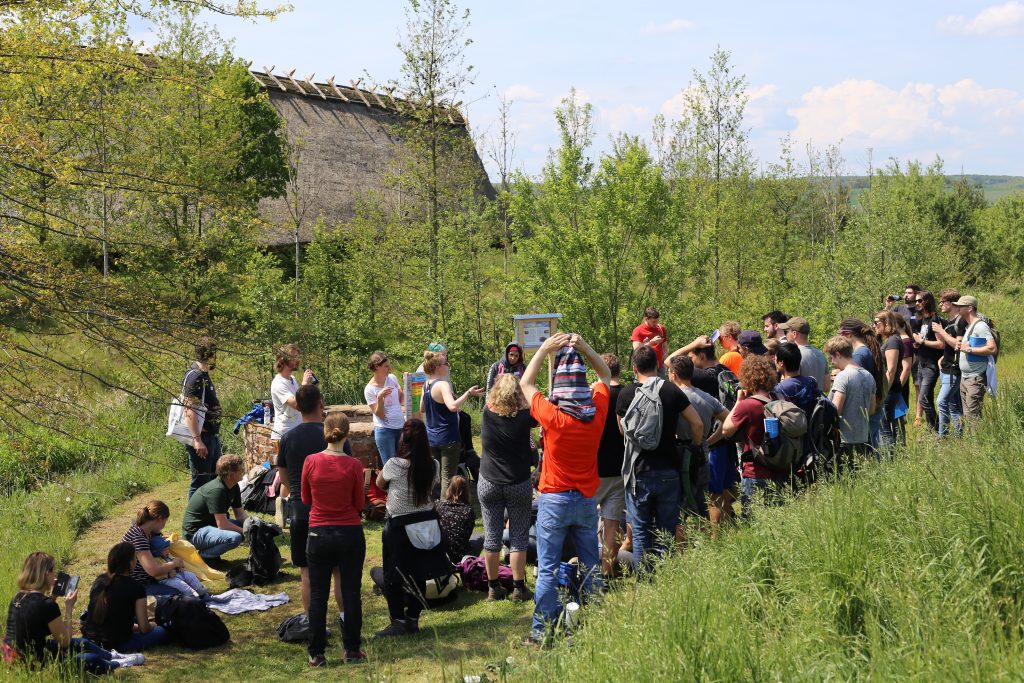
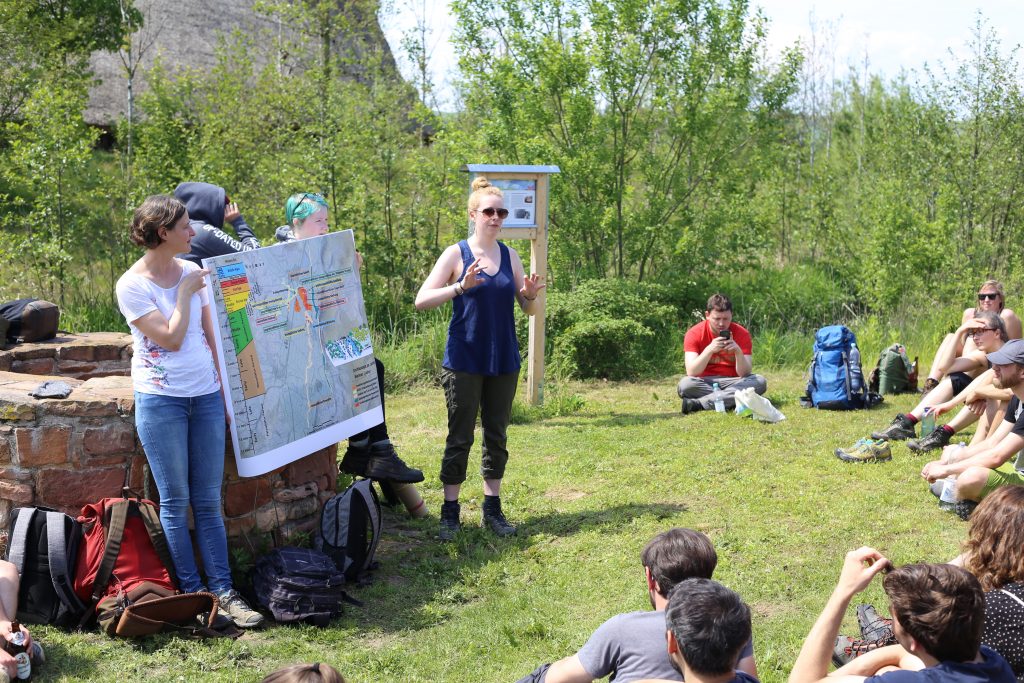
General points
On Sunday morning, three chairpersons and a support team of seven young geomorphologists were elected: Johannes Buckel (TU Braunschweig), Stefan Haselberger (University of Vienna) and Anna Schoch (University of Bonn) will chair the YG for a two-year period until the 2021 meeting. They are supported by Mario Kirchhoff (Trier University), Simon Meyer-Heintze (University of Würzburg), Jörn Profe (Justus-Liebig-University Gießen), Stefanie Tofelde (University of Potsdam), Julian Trappe (University of Würzburg), Renee van Dongen (GFZ-Potsdam), and Janek Walk (RWTH Aachen) in the upcoming tasks.
Jun.-Prof. Dr. Julia Meister (University of Würzburg) will organize the 14th international meeting of the German Young Geomorphologists group. It will take place near Würzburg from June 26-28, 2020.
The YG group is thankful for the financial support of the AK Geomorphologie and sponsoring institutions (see attached) which makes it possible to run a Young Geomorphologists’ meeting every year affordable for young scientists. We also thank Simon Meyer-Heintze (University of Würzburg) for handling participant communication. We would like to specially thank Prof. Dr. Todd Ehlers for his excellent keynote lecture, Dr. Johanna Lomax and Andrea Junge for guiding the great excursion. Finally, we are much obliged to Christian Halla (University of Bonn) and Julia Meister (University of Würzburg) for their commitment, effort and excellent work during the last two/four years as chairpersons of the YG.
Overall, the feedback for the meeting was very positive, however participants would like to have more time for scientific presentations and discussions in general (spotlights, posters, and excursion).
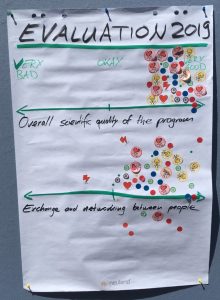
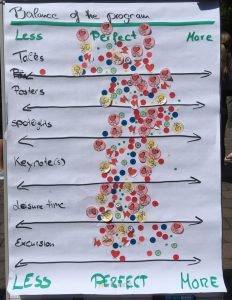
One key point learnt from the feedback discussion is that 60 participants represent the capacity limit of such a meeting. The new board will develop strategies how to cope with potentially more than 60 registrations in the future. There was a lively discussion about spotlights and how to improve their outcome for the young scientists opting for this presentation format. While the mixed spotlight and oral sessions received very positive feedback, new formats of small-group discussions were put on the table. Parallel sessions with small-group or “fish-bowl” discussions were debated with participants also emphasizing the danger of losing partly the interdisciplinary character of this meeting by temporally splitting the group. One option to avoid splitting the group might be spotlight-related additional discussions that are announced during spotlights and that take place during leisure time for interested persons. In addition, there should be one session dedicated to non-scientific but work-related issues in order to thrive on the challenging work environment for early-career scientists.
Concerning the field trip, the group suggested to have more guided discussions related to specific topics. Furthermore, the group identified the demand for a workshop on e.g. graphic design or dendrogeomorphology. Finally, the participants highlighted the importance of getting to know each other and thus recommended more introductory games at the beginning of the meeting.
The poster session was carried out on two evenings with no change in terms of content. The posters stay on the boards the whole meeting. The advantage is a time-independent opportunity to read and to discuss the presented topics.
12th International Workshop of Young Geomorphologists, 25-27 May 2018
(Report_and_Program_2018)
The German Young Geomorphologists (YG) conducted the 12th International Young Geomorphologists’ meeting in Stadtoldendorf from May 25-27, 2018. 49 German and international guests from Austria, Italy, Slovakia, India and Switzerland gathered close to Hildesheim for a three-day meeting. The list of attendees comprised undergraduate, graduate and PhD students as well as postdocs from 20 different universities and institutions. The focus was to present and discuss own research and general geomorphological topics in a rather informal and friendly environment.
The main frame of the program consisted of three blocks of oral presentations, one block of spotlight presentations, two poster sessions, two keynotes, and an excursion (see detailed program attached). The sessions for oral presentations were organized as follows:
Session II – Spotlights featuring talks by Johannes Buckel (TU Braunschweig), Christian Halla (University of Bonn), Heidi Bernsteiner (University of Salzburg), Anna Igelseder (University of Vienna), Jakob Heinzle (University of Vienna), Matthias Konzett (University of Vienna)
Session III: “Hard rocks and hard wood” featuring talks by Jörn Profe (University of Bremen/University of Gießen), Gerald Raab (University of Zurich), Dorothée Post (University of Vienna)
Session III: “Soil erosion, human impact and fluvial morphology” featuring talks by Johannes Schmidt (University of Leipzig), Stefan Haselberger (University of Vienna), Anna Kidova, Milos Rusnak, Milan Frandorfer (Slovak Academy of Sciences)
Proceedings
The program started with the usual introductory games where the participants shortly introduced themselves and their research projects (“Scales Game”). The attendees could continue the get to know each other during dinner. This was followed by an “After Dinner Talk” with Prof. Dr. Andreas Lang (University of Salzburg) “On formative events, conserving topography and morphologic hysteresis – a geomorphological trajectory”. The talk was followed by a very lively discussion on careers in geomorphology and academia in general. Afterwards, the persons responsible for the individual posters were asked to advertise their work with one slide in a limited time of 30 seconds (for further details on the broad selection of topics see program in the attachment). This was followed by the actual poster session, which was open ended, so that discussion kept on going far into the night.
Saturday began with the second keynote presentation by Dr. Peter Fischer (University of Mainz) entitled “Terrestrial System Response to North Atlantic Climate Oscillations during the Last Glacial Period a new high- resolution Loess-Palaeosol-Sequence from the Schwalbenberg (Middle Rhine Valley, Germany)”. The keynote lecture was followed by the first session of oral presentations on “Paleoenvironmental Research”. Afterwards, the organizing team of the German YG gave a short overview of their activities in the past year and upcoming events (e.g. YG session at EGU, social events at conferences, YG meeting 2019 in Gießen). The YG introduced funding possibilities and awards from the AK Geomorphologie that are available to the YG members of the AK. Furthermore, we put our focus on the upcoming joint AK Geomorphologie and DEUQUA conference, the “Central European Conference on Geomorphology and Quaternary Sciences”, in Gießen and the election that will take place during the conference.
After lunch, Jun.-Prof. Dr. André Kirchner (University of Hildesheim) led an excursion to the sourroundings of Stadtoldendorf, where the participants could observe geomorphological features of the area (dolines, loess deposits and soil profiles, etc.). The first stop of the excursion was a close by surface mine (see pictures below), where anhydrite and gypsum are excavated and the regional geologic and geomorphological setting was elaborately introduced and explained. At the following stops soil profiles and sinkholes were shown, explained and discussed. Furthermore, there was plenty of time for continued discussions and networking as well as gaining impressions of the beautiful surroundings during the excursion.
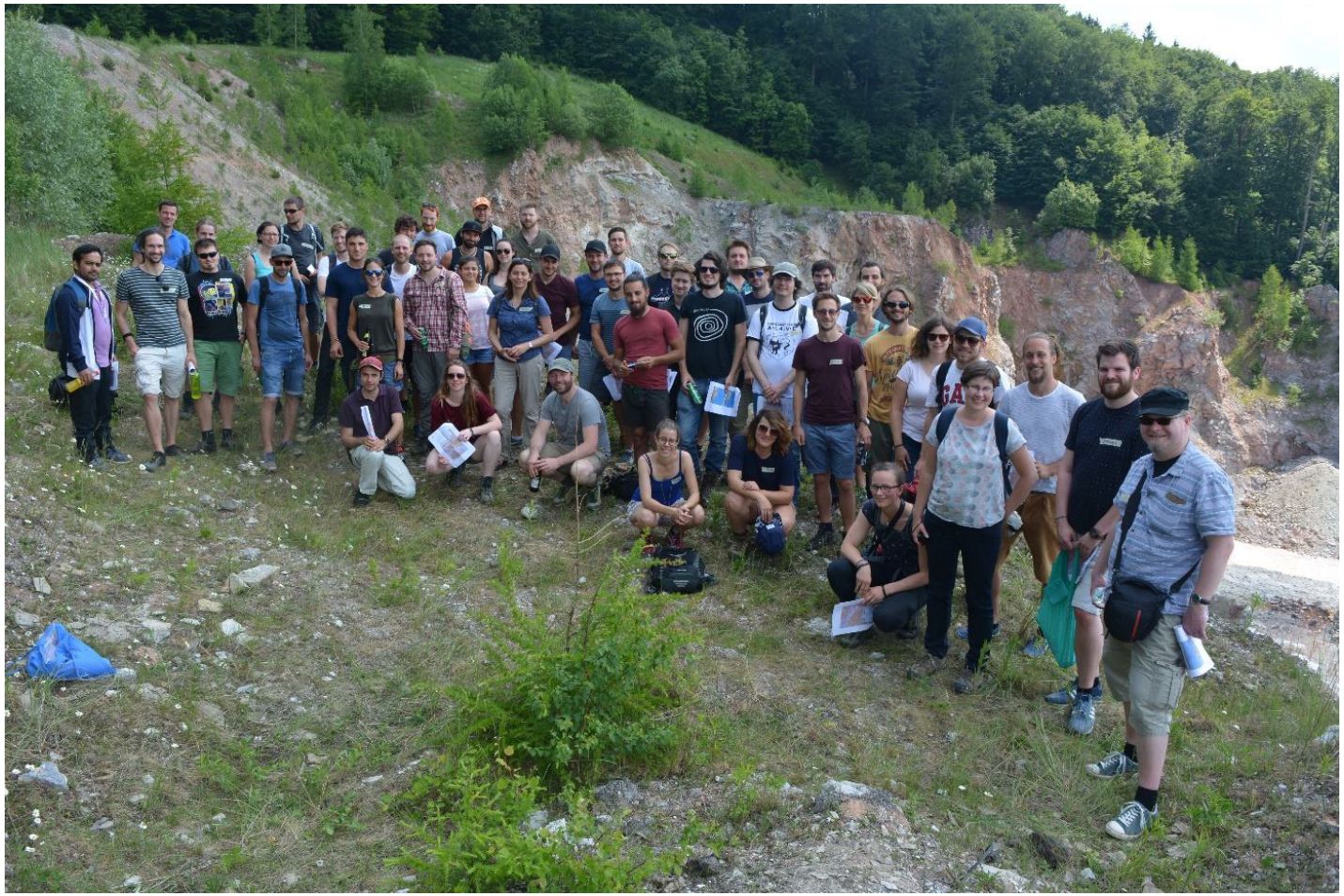
The Spotlights-session was scheduled after the field trip. Spotlights are a new format with a maximum of 5 minutes of presentation which is followed by an in depth discussion of 10 minutes or more. This gives young researchers the opportunity to present their work in progress, unsolved problems or issues they face during their research. After dinner, the evening ended with the continuation of the poster session. On Sunday, the program started with two sessions of oral presentations on “Hard rocks and hard wood” and “Soil erosion, human impact and fluvial morphology”. The meeting ended with an evaluation of the conference and an open feedback round after lunch (see feedback).

Last years’ feedback included the comments to have more time for scientific presentations and discussions in general. Thus the YG meeting was followed by a two-day YG workshop on “Multidisciplinary subsurface exploration – Direct Push, Vibracoring and ERT” (May 28-29, 2018) organized by Jun.-Prof. André Kirchner (University of Hildesheim), Dr. Peter Fischer (University of Mainz) and their colleagues in Hildesheim. The very interesting and successful workshop had 20 participants and was a great addition to the YG meeting.
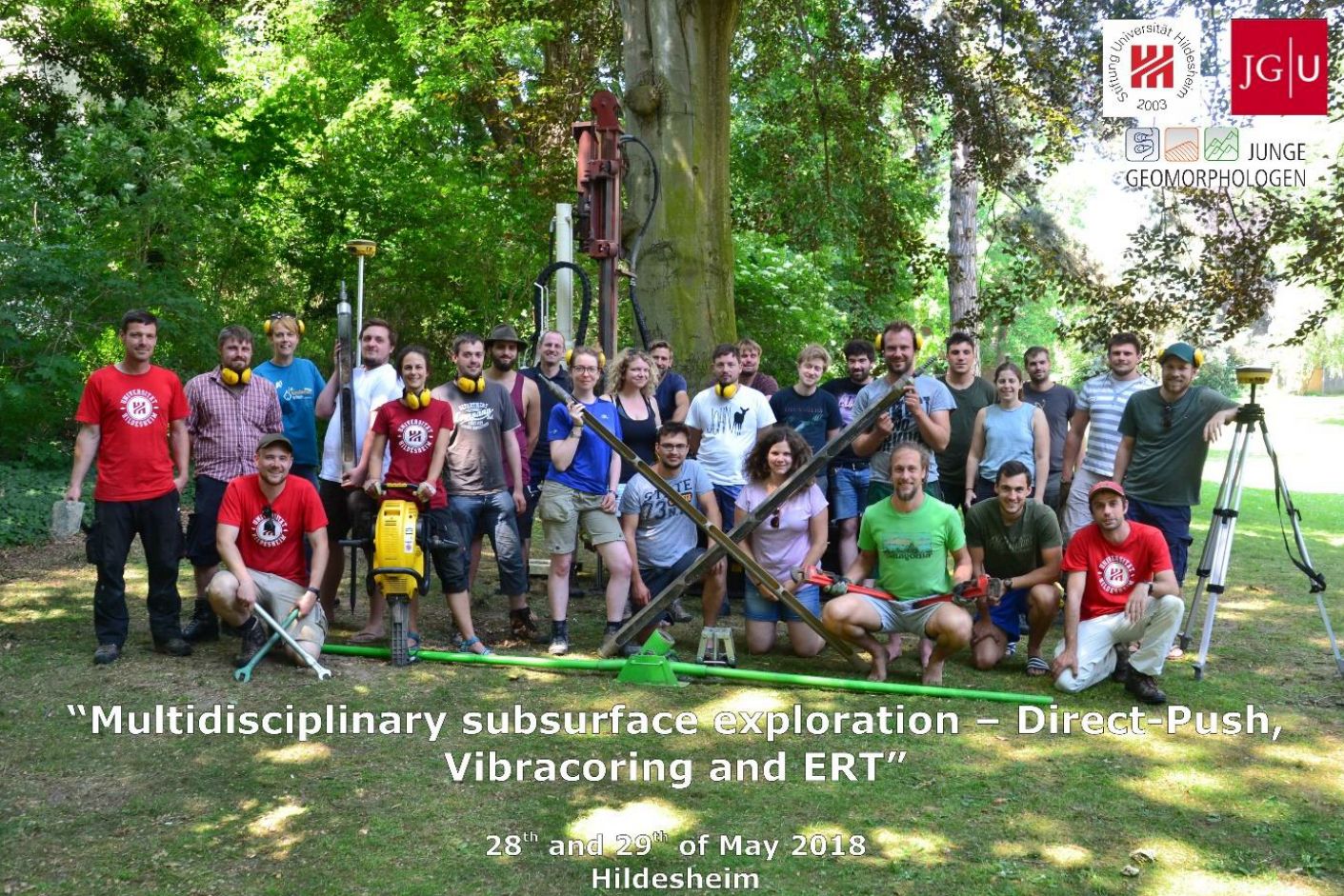
Feedback
Overall, the feedback on the meeting was very positive. The new session with spotlight was a great success and almost all participants of the workshop would like to have more spotlight-presentations at the next meetings. These sessions put the focus on scientific discussions (min. 10 minutes) instead of the presentations (max. 5 minutes). Other than that, the participants were very satisfied with the balance of the program.
During an open feedback round the participants mentioned the great venue (Waldpädagogikzentrum Weserbergland), the good size of the group (limited to 50 participants), the excursion by foot (no cars needed during the weekend) and the two keynote lectures. The attendees mentioned they would like to have two keynote lecture at all meetings, one on Friday focusing on a general topic (“After Dinner Talk”) and one scientific presentation on Saturday. The group played several games (table tennis, Frisbee, Kan Jam) during the breaks and in the evenings which added to a very positive atmosphere in the group.
Concerning new additions to the program it was suggested to have a workshop focusing on scientific discussions in the group (e.g. on the future of geomorphic research or research integrity and ethics). Furthermore, some participants would like to have an additional practical workshop on a certain method during the weekend. However, it is very challenging to fit more items to the already dense agenda and instead of adding an extra day to the program an additional workshop following the meeting was organized at the University of Hildesheim.
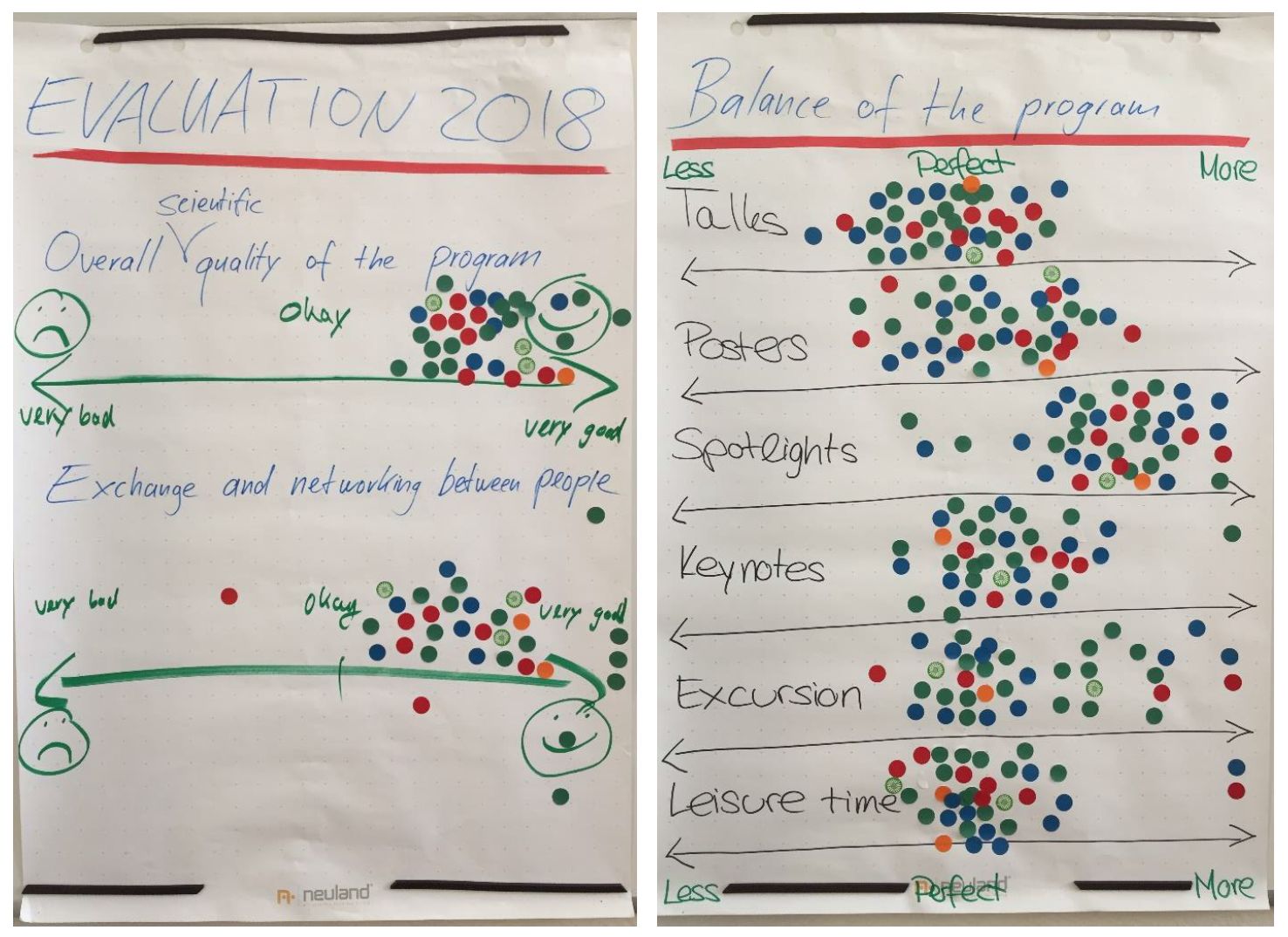
General points
The YG group is thankful for the financial support of the German Working Group on Geomorphology (AK Geomorphologie) and sponsoring companies (see attached) which makes it possible to run a Young Geomorphologists’ meeting every year affordable for young scientists. We also thank Simon Meyer-Heintze (University of Würzburg) for handling the participant communication. We would like to specially thank Prof. Dr. Andreas Lang and Dr. Peter Fischer for their excellent keynote presentations, Jun.-Prof. André Kirchner for guiding the great excursion, as well as Jun.-Prof. André Kirchner and Jasmin Karaschewski for organizing this great meeting in Stadtoldendorf.
Andrea Junge, Raphael Steup and Tilmann Wolpert (University of Gießen) will organize the 13th international meeting of the German Young Geomorphologists group. It will take place near Gießen/Marburg from May 17-19, 2019.
The three chairpersons and a support team of six young geomorphologists who were elected in 2017 will organize the activities of the YG in the upcoming year. The members of the team are Johannes Buckel (University of Salzburg), Christian Halla (University of Bonn), Jasmin Karaschewski (University of Hildesheim), Julia Meister (FU Berlin), Simon Meyer-Heintze (University of Würzburg), Anna Schoch (University of Bonn), Anne Schuchardt (University of Halle), Philipp Schulte (University of Aachen), and Anne Voigtländer (Technical University of Munich/GFZ).
Johannes Buckel, Christian Halla, Jasmin Karaschewski, André Kirchner, Julia Meister, Simon Meyer-Heintze, Anna Schoch, Anne Schuchardt, Philipp Schulte and Anne Voigtländer
11th International Workshop of Young Geomorphologists, 19-21 May 2017
(Report_2017, Program_2017, Story map of the field trip)
The German Young Geomorphologists (YG) conducted the 11th International Young Geomorphologists’ Workshop at the Ammersee from May 19-21, 2017. 57 German and international guests from Austria, Italy, Poland, and Switzerland gathered close to Herrsching for a three-day workshop. The list of attendees comprised undergraduate, graduate and PhD students as well as postdocs from 21 different universities and institutions. The focus was to present and discuss own research and general geomorphological topics in a rather informal and friendly environment.
The program started with a short introduction of the group of Young Geomorphologists and the participants shortly introduced themselves. The attendees could continue the get to know each other during dinner. Then the first session of oral presentations on „Landslides and Loess“ took place. Afterwards, the persons responsible for the individual posters were asked to advertise their work with one slide in a limited time of 30 seconds (for further details on the broad selection of topics see the program). This was followed by the actual poster session, which was open ended, so that discussion kept on going far into the night.
Saturday began with the keynote presentation of Dr. Wolfgang Schwanghart (University of Potsdam) entitled “Models, parameters, and the unknown unknowns – issues in Landscape Evolution Modelling”. After lunch, Prof. Dr. Michael Krautblatter (Technical University of Munich) gave a short introduction into the glacially formed landscape of the surrounding of the Ammersee. He then led an excursion to the monastery of Andechs, where the participants could observe the geomorphological forms (drumlins, moraine ridges, etc.) which were left by the Wurmian glaciation in the field. The trip also provided the opportunity for further discussion and networking. One key aspect of the following general assembly of the German Young Geomorphologists was the election (held every two years) of the chairpersons and a support team of further young scientists. The evening ended with the continuation of the successful poster session.
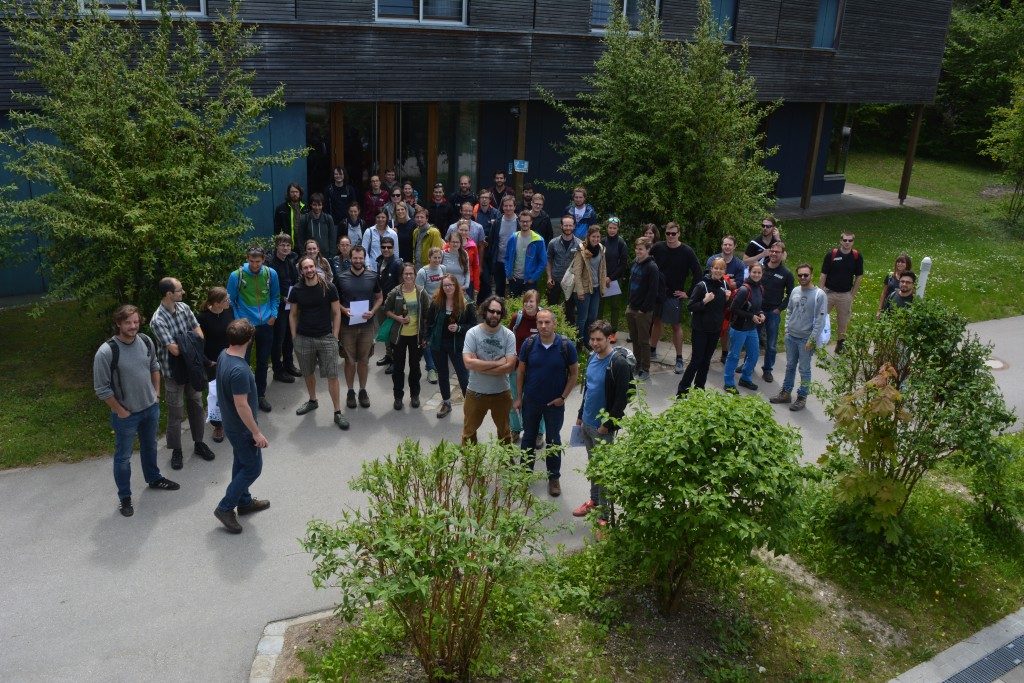
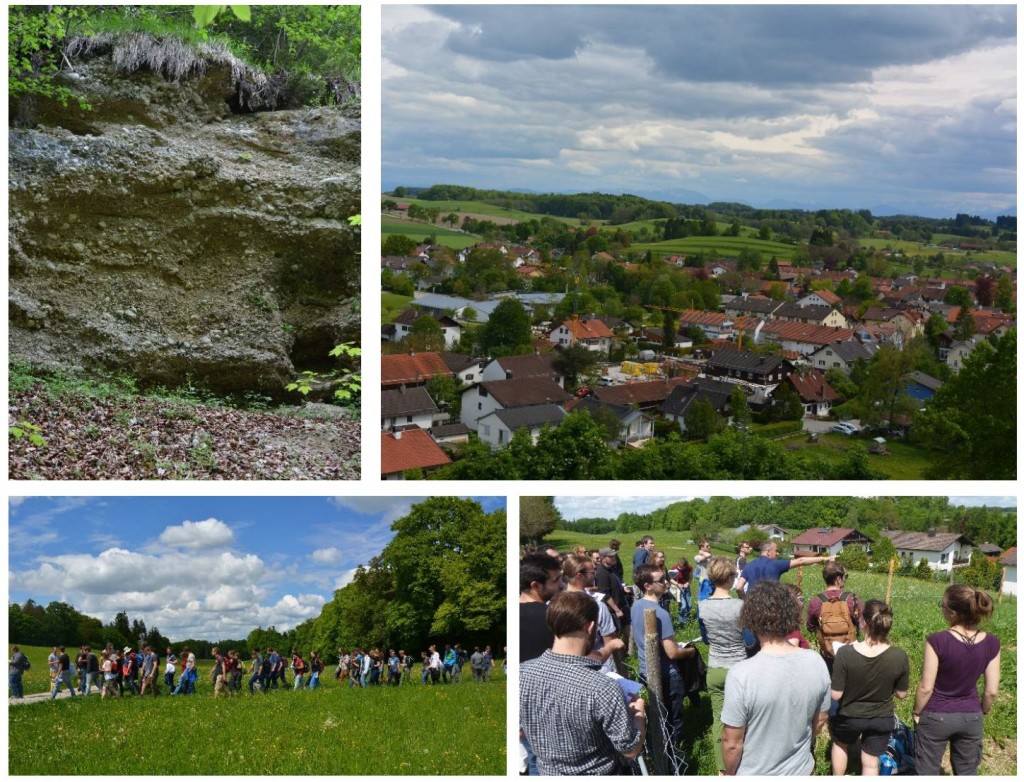
On Sunday the program started with a change in the agenda. The first topic “Q&A 10 years later – open discussion with the “older” Young Geomorphologists” were convened by the organizing team of the YG. There was an open discussion where the young scientists could ask former founders and speakers of the YG (Dr. Sabine Kraushaar, Prof. Michael Krautblatter, Dr. Wolfgang Schwanghart) as well as a regular participant of the annual meetings and long-time support team member (Dr. David Morche) about their intentions on founding the group, the development of the group and perspectives on science. Important topics were early career planning, family (planning) and the increasing demands made on (young) scientists. The second part of the last meeting-day was the Session II: “(High) Mountain geomorphology” featuring oral talks by five participants.
10th International Workshop of Young Geomorphologists, 27.-29. May 2016
(Report_and_Program_2016)
The 10th International Young Geomorphologists’ Workshop, organized by the German Young Geomorphologists (YG) was held from May 27-29, 2015 in Werbellinsee, northeast of Berlin. It was the third time after 2014 that international participants were explicitly invited. In total, 45 undergraduate, graduate, PhD students, and postdocs from 17 different Institutions and Universities (and 3 countries, including , Austria and Germany) came together for a three-day workshop to discuss their own research, as well as topics of geomorphologic interest in general, in a rather informal environment.
After a casual introduction of the participants this year’s program started in the evening (19:30 – 21:30) with a Keynote lecture on “The Geophysics and Geochemistry of Geomorphology: why surface processes matter in the big picture, and how we use scary tools to learn about them”, presented by Prof. Niels Hovius (GFZ Potsdam). Following this and a “Late-Night” poster session (22:00 – 23:30) with accompanying 30 seconds introductory talks from all presenters (see attached program for further details). Even though it was already late at night, the poster session was a great success and participants kept on discussing until midnight.
On Saturday the workshop started with a session on “Sediment – Surface – Erosion”, featuring 5 oral talks by participants between 09:00 and 11:00, before the group left for a short field-trip to the surroundings of Werbellinsee. The field trip was organized by Dr. Knut Kaiser (GFZ Potsdam), who introduced the group to the postglacial landscape features of the region. Returning from the field trip, the data acquisition for the workshop on on Unmanned Aerial Vehicles (UAV) was accomplished at the lake side, where we also took the opportunity of taking nice group pictures. In the evening, the second poster session with accompanying 30 seconds introductory talks was held (see attached program for further details). Here, we took advantage of the nice weather conditions and held an outdoor poster session, which proved to be highly recommendable for future events.

On Sunday morning the second session on “Transport – Interactions” was held, featuring two oral presentations. Following the oral block, Dr. Kristen Cook (GFZ Potsdam) gave a hands-on workshop on UAV data processing and Structure from Motion analysis, using the data collected at the lake shore on Saturday night.
9th International Workshop of Young Geomorphologists, 8.-10. May 2015
(Report_and_Program_2015) (Blog entry in the BSG Postgraduate Forum)
The 9th annual meeting of the German Young Geomorphologists (YG) was held from the 8th until the 10th of May 2015 in Heimbach-Hergarten in the vicinity of the Eifel Nationalpark, southeast of Aachen. It was the second time after 2014 that international participants were explicitly invited. In total, 41 undergraduate, graduate, PhD students, and postdocs from 16 different Institutions and Universities (and 5 countries, including UK, Australia, Belgium, Austria and Germany) came together for a three-day workshop to discuss their own research, as well as topics of geomorphologic interest in general, in a rather informal environment.After a casual introduction of the participants this year’s program started with a “Late-Night” poster session and accompanying 3 min. introductionary talks from all presenters (see attached program for further details). On Saturday morning, Prof. Sean Willet from ETH Zurich gave a “Wake-up lecture” entitled “River network response to tectonic forcing” which was followed by a Keynote talk given by Prof. Frank Lehmkuhl from RWTH Aachen about “Geomorphology: Processes and landscape evolution for geoecology, hydrology and geoarcheology. Examples from the Eifel Mountains towards the lower Rhine Embayment, Western Germany”.
A field trip to the surroundings of Heimbach-Hergarten was organized and held by Prof. Wolfgang Römer from RWTH Aachen. The fieldtrip focused on the geologic architecture of the Eifel orogeny and geomorphologic imprints of Cenozoic tectonics including middle Pleistocene terraces and meander cutoff development The program for the next two days included 11 work-in-progress reports as well as reports from advanced PhD-projects which were organized in three sessions (see attached report for details).
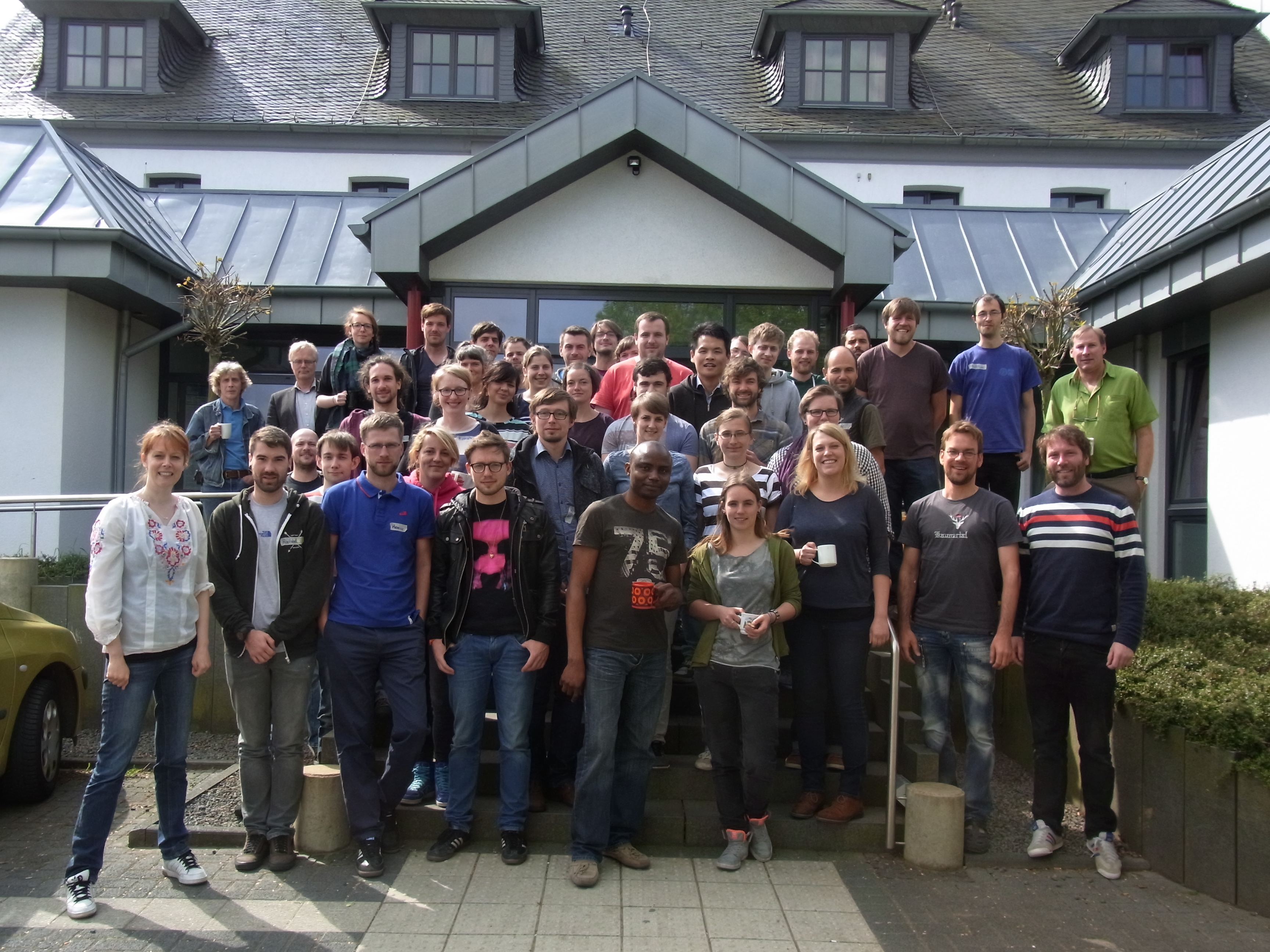
8th International Workshop of Young Geomorphologists, 23.-25. May 2014
(Program2014) (Report2014)
For the 8th annual meeting of the Jungen Geomorphologen we were gathering on the island of Usedom, on the coast of the Baltic Sea. For the first time the meeting was held in English in order to open it for the international community of young geomorphologists. We were very glad to have participants from France, the USA and South Africa joining for the meeting. In total, we had 41 undergrads, PhD Students, and PostDocs from 14 different Institutions/Universities gathered for three days to discuss their own research, as well as topics of geomorphic interest in general, in a rather informal environment. For the first time we sucessfully organized an evening poster session, in order to allow more participants to present and discuss their work. The program was completed by three presentations from invited speakers:
- “The Cosmogenic Nuclide Clock of Earth Surface Processes” Keynote by Prof. Friedhelm von Blanckenburg (GFZ Potsdam),
- “Mecklenburg-Vorpommern: Glacial landscapes and a lot more below” Keynote and field trip by Prof. Henrik Rother (Uni Greifswald),
- “Successful proposal writing” Workshop by Prof. Brigitta Schütt (FU Berlin)
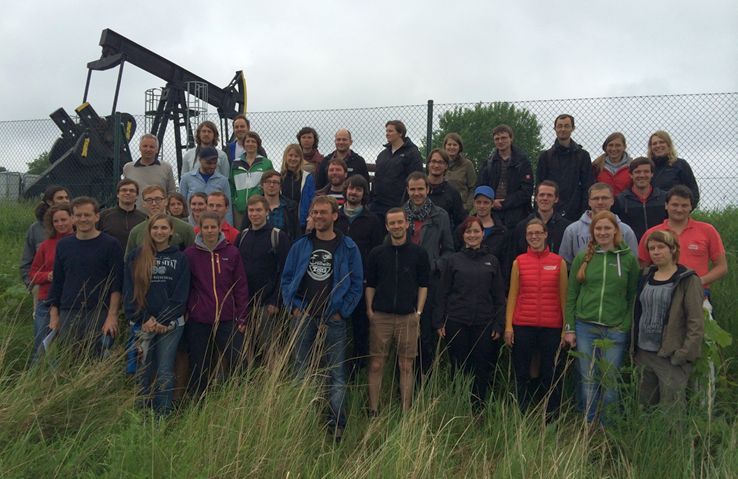
7. Arbeitstreffen, 4.-6. October 2013
(Program2013) (Report2013) (Foto2013) (Foto2013)
The 7th annual meeting of the German Young Geomorpholgists group (YG) was held in Fleckl (Warmensteinach, Fichtel Mountains, Bavaria). This year, 24 Undergrads, PhD Students, and PostDocs from 13 different Institutions/Universities gathered for three days to discuss their own research, as well as topics of geomorphic interest in general, in a rather informal environment. In addition to the presentations and discussions indoor, a hands-on workshop on the use of terrestrial laser scanning (TLS) in geomorphology was held, where participants could familiarize with the methodology and equipment of this approach, and discuss geomorphological applications. An afternoon field trip was organized on Saturday, during which geomorphological aspects of the Fichtel Mountains, their land-use and mining history were introduced by Mathias Will (Uni Exeter).
- Keynote presentaion by Dr. Christian Tinapp – Geoarchaeology
- Keynote presentation by Prof. Markus Fuchs – OSL Dating
- Keynote presentation by Jan Blöthe – Geohazards in mountainous terrain
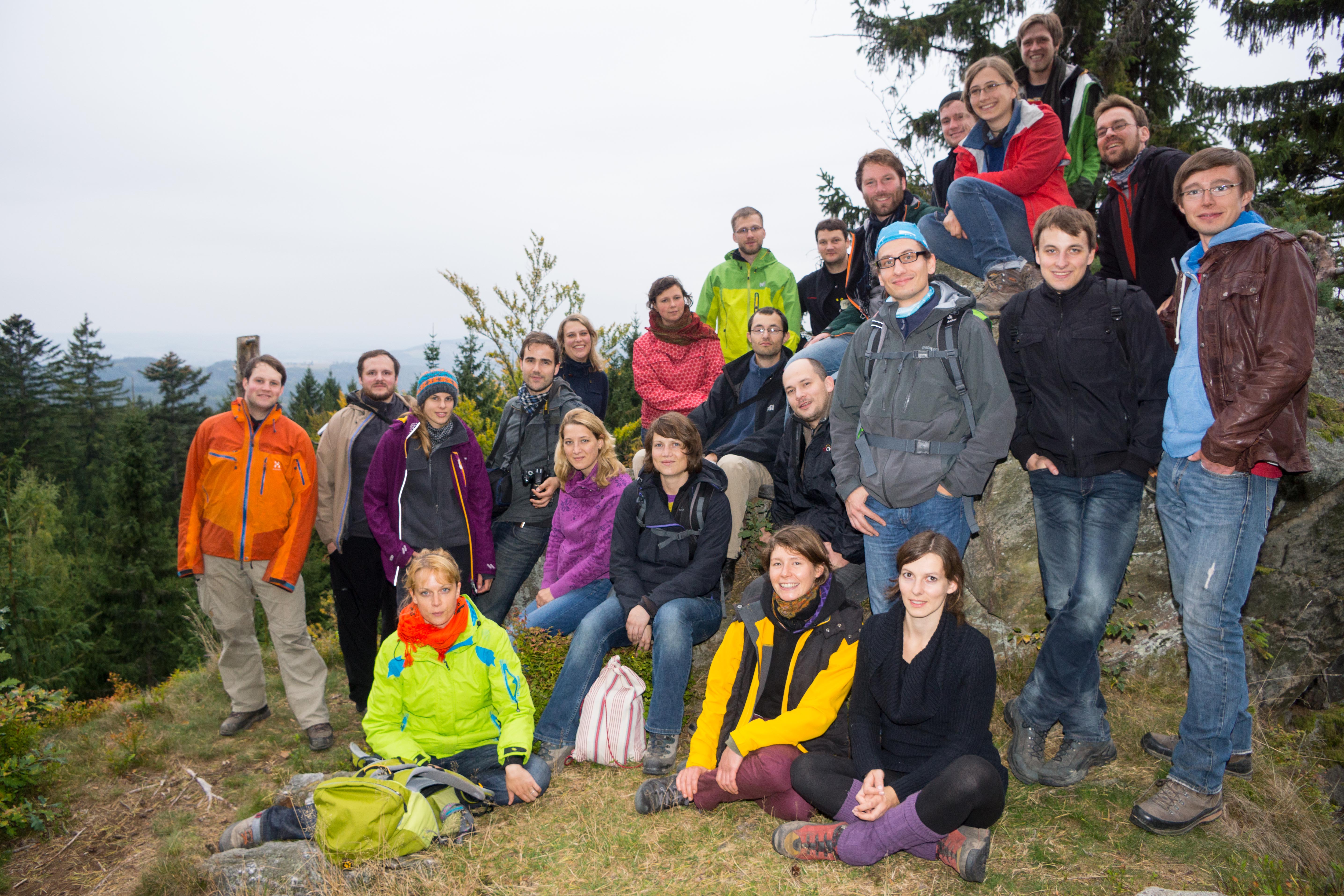
6. Arbeitstreffen, 14.-16.10.2012
(Programm2012) (Bericht2012) (Foto2012)
Das sechste Arbeitstreffen der Jungen Geomorphologen fand 2012 in Aicha (Eichstätt) statt. Eine Vorexkursion (geleitet von Peter Fischer, Eichstätt) führte in den Donau-Auwald. Das Arbeitstreffen thematisierte mit Keynote-Vorträgen Landscape Evolution Modelling (Wolfgang Schwanghart, Potsdam) und Robuste Auswertung multivariater Daten (Elisabeth Dietze, Potsdam). Die Fachvortragsblöcke umrissen die Themen „Sedimentflüsse und Landschaftsdynamik“ sowie „Angewandte Geomorphologie“. Drei Workshops, u.a. von Stuart Lane (Lausanne) zum Thema „Authorship as a young geomorphologist“ (pdf), füllten die drei Tage des Arbeitstreffens reichhaltig. Die bisherigen Sprecher, Sabine Kraushaar (Leipzig) und Michael Dietze (Dresden), wurden bestätigt.
- Keynote-Vortrag von W. Schwanghart
- Keynote-Vortrag von E. Dietze
5. Arbeitstreffen, 01.-03.10.2011
(Programm2011) (Bericht2011)
Das fünfte Arbeitstreffen der Jungen Geomorphologen fand 2011 in Freienorla (Jena) statt. Entsprechend der Thematik der AK-Tagung behandelten die Keynote-Vorträge periglaziale Hangsedimente und den Wert von Böden und Sedimenten als Umweltarchiv. Ein weiterer Keynote-vortrag behandelte die Wissenschaftsförderung in Deutschland. Die Wanderung führte durch den Thüringischen Muschelkalk und Buntsandstein. Als neue Sprecher wurden Sabine Kraushaar und Michael Dietze gewählt.
4. Arbeitstreffen, 23.-25.04. 2010
(Programm2010) (Bericht2010)
Das vierte Arbeitstreffen der Jungen Geomorphologen fand 2010 in Wilhelmsaue (Oderbruch) statt. Keynote-Vorträge und Diskussionen u.a. zu Forschungsanträgen und Förderungsmöglichkeiten bildeten den fachlichen Kern. Die Wanderung führte durch die Brandenburger Jungmoränenlandschaft. Die bisherigen Sprecher, Michael Krautblatter und Wolfgang Schwanghart, wurden bestätigt.
3. Arbeitstreffen, 04.-06.04. 2009
(Bericht2009)
Das dritte Arbeitstreffen der Jungen Geomorphologen fand 2009 in Herrischried (Südschwarzwald) statt. Die projektbezogenen Vorträge waren meist Werkstattberichte und ermöglichten methodische und inhaltliche Diskussionen. Der Themenschwerpunkt des Treffens hatte den Titel: Alleskönner Geomorphologen? Beiträge der Geomorphologie zu interdisziplinärer Forschung. Außerdem wurden übergeordnete Diskussionsrunden eingerichtet. Als neue Sprecher wurden Michael Krautblatter und Wolfgang Schwanghart gewählt.
2. Arbeitstreffen, 05.-06.04 2008
(Programm2008) (Bericht2008)
Das zweite Arbeitstreffen der Jungen Geomorphologen fand 2008 in Schwrizheim (Eifel) statt. Neben den projektbezogenen Vorträgen stand die Theorie Komplexer Systeme im Fokus und inwiefern sich diese Ansätze als wissenschaftstheoretischer Rahmen in wissenschaftliche Arbeiten integrieren lassen kann. Während des Treffens wurde das aktuelle Logo und der Name selbst entwickelt. Thomas Hoffmann als kommissarischer Sprecher der Jungen Geomorphologen gewählt. Die Wanderung unter Führung von Manuel Seeger führte zum Meerfelder Maar.
1. Arbeitstreffen, 29.04.-02.05.2007
(Bericht2007)
Das erste Arbeitstreffen der Jungen Geomorphologen fand 2007 in Wartaweil (Ammersee, Bayern) statt.


















